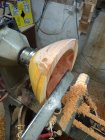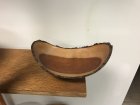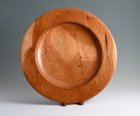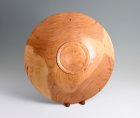-
April 2025 Turning Challenge: Turn an Egg! (click here for details) -
Congratulations to Kelly Shaw winner of the March 2025 Turning Challenge (click here for details) -
Congratulations to Ellen Starr for "Lotus Temple" being selected as Turning of the Week for 21 April, 2025 (click here for details) -
Welcome new registering member. Your username must be your real First and Last name (for example: John Doe). "Screen names" and "handles" are not allowed and your registration will be deleted if you don't use your real name. Also, do not use all caps nor all lower case.
You are using an out of date browser. It may not display this or other websites correctly.
You should upgrade or use an alternative browser.
You should upgrade or use an alternative browser.
Cherry wood
- Thread starter Gary Beasley
- Start date
I have had trouble with cherry sap wood checking, much more than the heart wood. The sap wood usually comes out a cream color when dry.
The black cheery that I have turned either from green or dried lumber used for segmented work will dry with very little color change similar to the goblets recently turned green this week however they are dry due to having a wall thickness of about 1/32".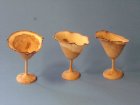 The color will darken over time with exposure to light even with a finish.
The color will darken over time with exposure to light even with a finish.
 The color will darken over time with exposure to light even with a finish.
The color will darken over time with exposure to light even with a finish.Here are a couple of pictures of a NE black cherry bowl I turned wet (frozen) about 10 days ago and nearly dry today.
It started out with a nice yellow/orange color similar to your picture, but now has only a subtle salmon color. Once it is sanded/finished and exposed to some light, it might retain a little of the salmon color, but will likely be overwhelmed by the color of the heartwood.
wet: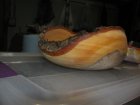
dry:
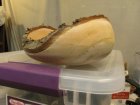
It started out with a nice yellow/orange color similar to your picture, but now has only a subtle salmon color. Once it is sanded/finished and exposed to some light, it might retain a little of the salmon color, but will likely be overwhelmed by the color of the heartwood.
wet:

dry:

- Joined
- Apr 27, 2004
- Messages
- 9,161
- Likes
- 5,768
- Location
- Lakeland, Florida
- Website
- www.hockenberywoodturning.com
In the video you can see the sapwood on a finished cherry bowl in the beginning and the sapwood on a rough turned bowl at the end. The color of both is quite similar. There is a little discoloration in the sapwood which is due to it sitting for a while before turning.
Generally the I get cherry sapwood to dry to an off white color or very pale tan.
Two dry cherry bowls ready for sanding this one has bark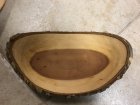 This one shows a hint of orange from heartwood staining.
This one shows a hint of orange from heartwood staining. 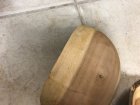
What color was the sapwood before you began hollowing? If it was more white you are likely getting heartwood staining. Compressed air will often blow the colored water from the sapwood out before it stains the wood.
View: https://www.youtube.com/watch?v=qZ0fC5Rk6h4
Generally the I get cherry sapwood to dry to an off white color or very pale tan.
Two dry cherry bowls ready for sanding this one has bark
 This one shows a hint of orange from heartwood staining.
This one shows a hint of orange from heartwood staining. 
What color was the sapwood before you began hollowing? If it was more white you are likely getting heartwood staining. Compressed air will often blow the colored water from the sapwood out before it stains the wood.
Attachments
Last edited:
Before turning it was mostly bark colored  . It was hard to tell much until I sliced in to it. It was so wet I was getting a shower from the sap. Im surprised folks havent tapped these trees to make syrup, the stuff smells good. If it dries down similar to your pictures Ill be quite satisfied. Thanks!
. It was hard to tell much until I sliced in to it. It was so wet I was getting a shower from the sap. Im surprised folks havent tapped these trees to make syrup, the stuff smells good. If it dries down similar to your pictures Ill be quite satisfied. Thanks!
Here is a cherry platter that I recently turned and finished with Tried And True oil varnish. The rough out had coloration very similar to yours. Once dried and returned, the sap wood was a creamy white. I expect the heart wood will continue to darken as it gets older. I think you will be pleased with your bowls once they are seasoned and re-turned. I prefer blanks with both heartwood and a little sapwood if I can get them.
Adam
Adam
Attachments
That is very nice Adam!
Color will stay a nice cream color in the begining. one thing to remember rule of thumb light woods get a shade or two darker over time and dark woods a shade or two lighter. But in the end it is the shape of the bowl that matters. shape far outweighs the color of any project turned.
Jerry
Jerry
The sap wood 'oxidizes' as it ages, which means it gets that orange/red color. For my once turned bowls, depending on how my turning skills were working that day, if I burnish at all by rubbing the bevel, those marks take at least 80 grit to remove. As the bowl ages, it will darken, and not stay that creamy white. Cherry will oxidize in 5 minutes in mid summer sun light...
robo hippy
robo hippy
Five days ago I twice turned a few black cherry bowls. After adding several coats of The Doctor's Woodshop Walnut Oil & Wax Finish, two days ago I started noticing the end grain darken with the side grain streaking a lighter color. My guess is end grain absorbs finish and cures faster than side grain. Will this darkening process eventually even out? Thanks for any clarification. I'm a bit concerned as the event is just two weeks away.
The only way I know to even out the oil absorption is to sand to a very high grit then maybe use a grain filler before oiling. End grain likes to eat oil.
A picture would help but it is likely the normal oxidation that always occurs with cherry.Five days ago I twice turned a few black cherry bowls. After adding several coats of The Doctor's Woodshop Walnut Oil & Wax Finish, two days ago I started noticing the end grain darken with the side grain streaking a lighter color. My guess is end grain absorbs finish and cures faster than side grain. Will this darkening process eventually even out? Thanks for any clarification. I'm a bit concerned as the event is just two weeks away.
I turn quite a bit of black cherry. As others have said, it darkens over time. I don't have many issues re cracking but once turned pieces can be very difficult to sand. It develops an oxidation layer while drying so I do a lot of MS wipes while sanding looking for brown/dirty colored lines and streaks that can be difficult to sand out. I almost always soak my once turned cherry pieces in a 50/50 mix of water and liquid dish soap. It makes sanding much easier once you then let them dry. It will also deepen the color of the sapwood as the color from the heartwood bleeds out into the water. After just a few pieces get soaked the water will be very red and dark. I like the darker look. Got the idea from Robo long ago.
Last edited:
That seems like a high concentration of dish soap?soak my once turned cherry pieces in a 50/50 mix of water and liquid dish soap.
It is. I don't get exact on ratios so likely not 50/50 but still a lot of soap per volume of water. I put it in a bucket and if it initially floats I put a rock on it. Robo has a video or two on it and after I wore myself out trying to sand some bradford pear and cherry I tried it. It does make a difference in being able to sand through that brown layer that gets on them. Likely helps with other pieces but too expensive to use on every piece plus once you use it for cherry you're committed to cherry.
The 50/50 is standard for the LDD/liquid dish washing detergent soak which was developed by Ron Kent of Hawaii for dealing with the Norfolk Island pine he turned. Use tan or lemon. The colored versions can dye your wood. The oxidation of the sap wood is a pain to deal with. You either have to spend a lot of time sanding it all back to white again, or just sand it smooth and leave the streaks because it will even out over time. That is what I usually do. I don't get any black cherry out here on the west coast. Most of what I got was orchard trees or the ornamental cherry. I didn't have NRSs back the last time I had cherry. That might have made a difference. I also turn to final thickness and let them warp. Not sure if twice turning would help get rid of the oxidation or not.
robo hippy
robo hippy

